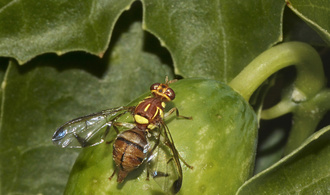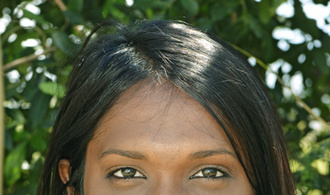Attractants for female melon flies
Written by Modified on the
Toulassi Atiama-Nurbel is a PhD student currently in her 3rd year* at the Plant Protection Centre (3P- CIRAD Réunion) and in August attended the ICEC 2013 International Chemical Ecology Congress in Melbourne, which brought together for the first time the International Society of Chemical Ecology (ISCE) and the Asia Pacific Association of Chemical Ecologists (APACE).
Your thesis is on "chemical ecology". What's this ?
- Chemical ecology, which includes a set of scientific disciplines, is about studying the role of chemical compounds as mediators of interactions between living species, whether animal or vegetable. I study of insect/plant interactions related to olfaction. How, for example, can an insect recognize a plant from a certain distance through olfaction?
Your thesis focuses on the fruit fly Bactrocera cucurbitae. Can you tell us about this pest?
- Bactrocera cucurbitae is currently a major pest of cucurbits in many countries around the world, particularly in Asia, many Pacific Islands, the Seychelles, East and West Africa, Mauritius and Reunion. In Réunion, production losses can reach 90%. Damage is caused by females laying their eggs and larval development inside the fruit. But for now, only males can be attracted and trapped with sexual stimuli, thus greatly reducing the coupling capacity with the females who cause damage without sufficiently reducing pest pressure.
So it was decided to focus on females of the species ?
- A decrease in the number of females means fewer eggs laid on fruit, and ultimately less damage. Females seeking fruit on which to lay their eggs are attracted by a mixture of volatile compounds emitted by the host plant. One aim of my thesis is to identify volatile chemicals to formulate effective attractants for females. In otherwords, what scents allow females to detect the host plant? However, although the effect of the smell of cucumber on the melon fly has been studied at the University of Hawaii, no research has yet been conducted on the olfactory effects of other plants on Bactrocera cucurbitae females.
How did the research take place?
- I first studied the scent attractiveness of fruit from 18 different species of the Cucurbitaceae family, including wild species and cultivated species in Reunion. For this, I used small test cages, allowing me to describe the behavioral responses of flies to these different scents using an olfactometer. After identifying the most attractive scent, I carried out, in collaboration with the Laboratoire de Chimie des Substances Naturelles et des Sciences des Aliments (LCSNSA) at the University of Réunion, a chemical analysis of volatile compounds, studied as a function of maturity and variety of the host plant.
So is there a link between the type of volatile compounds emitted and fly behaviour ?
- Yes. Using electroantennography chromatography coupled to gas chromatography (GC –EAG), a technique used on insects which I've recently used in the Czech Republic, volatiles will be separated by chromatography into their chemical components which will in turn be tested one at a time directly on the antenna of the insect, and reaction will be observed. Using a chemically complex smell, we were able to check which compounds insects specifically react to.
* Thesis title : Réponse des femelles de Bactrocera cucurbitae (Diptera,Tephritidae) aux effluves et aux composés volatils de fruits-hôtes.
Thesis director : Serge Quilici, Entomologist HDR, UMR PVBMT( Cirad/Université de la Réunion)
Thesis co-director : Anne Bialecki, Pr, Université de La Réunion (Laboratoire de Chimie des Substances Naturelles et des Sciences des Aliments)
Thesis co-supervisor : Jean-Philippe Deguine, Entomologist HDR, UMR PVBMT (Cirad/Université de la Réunion)

